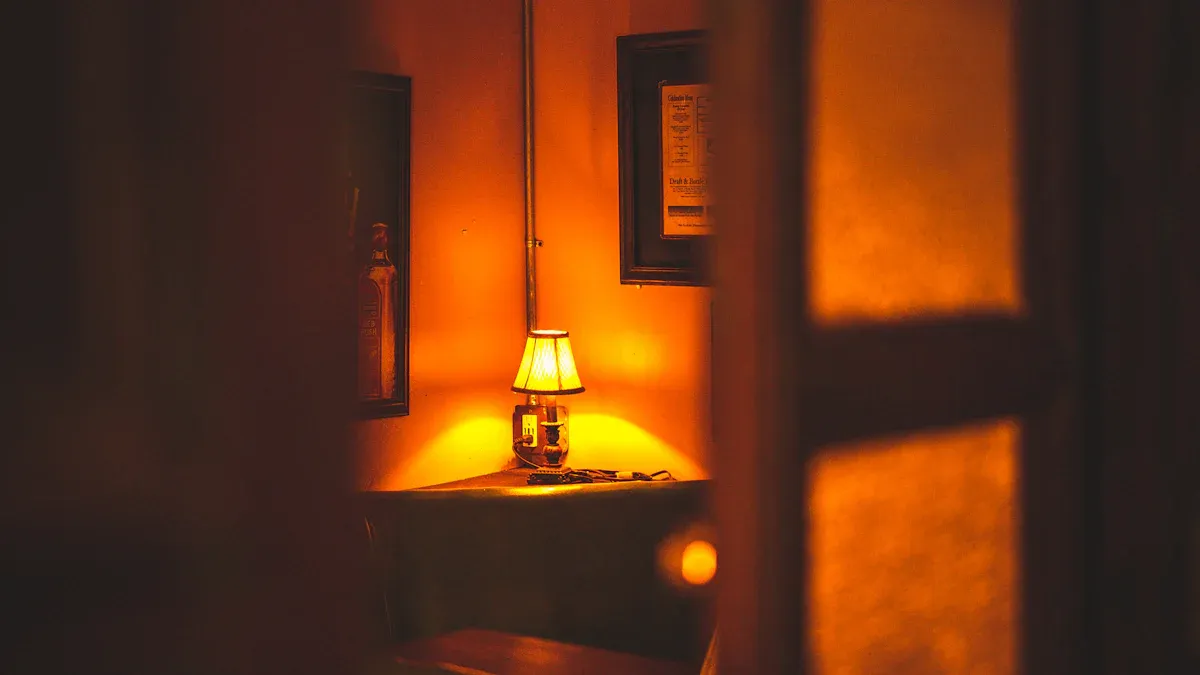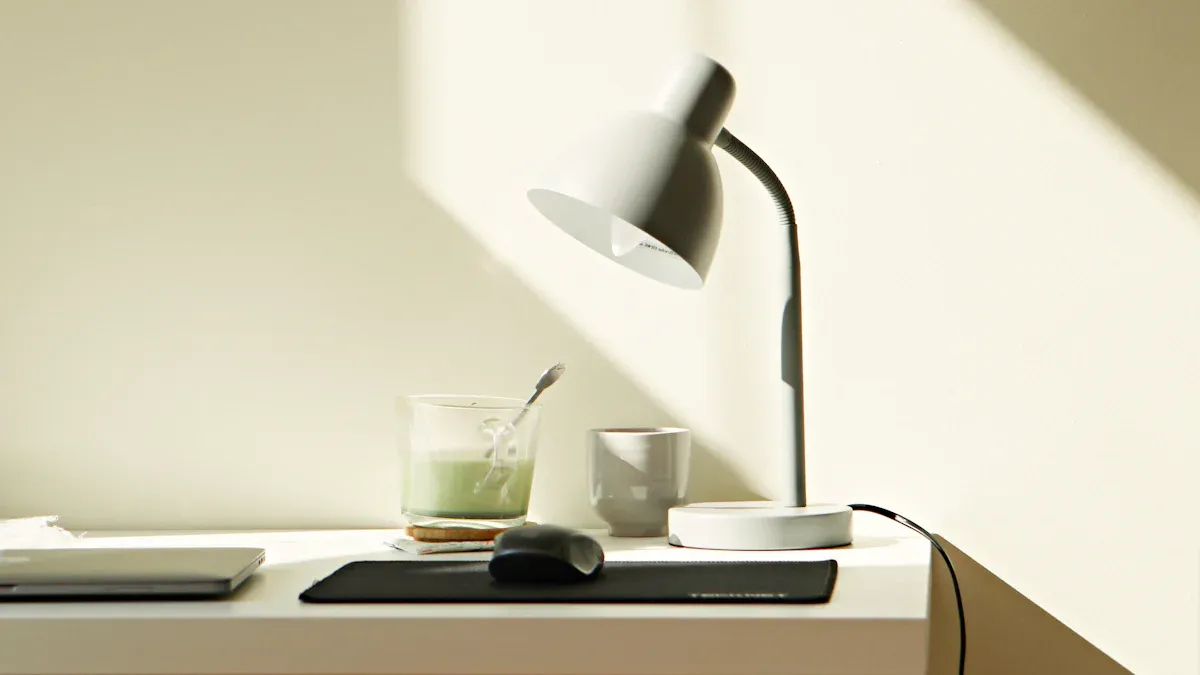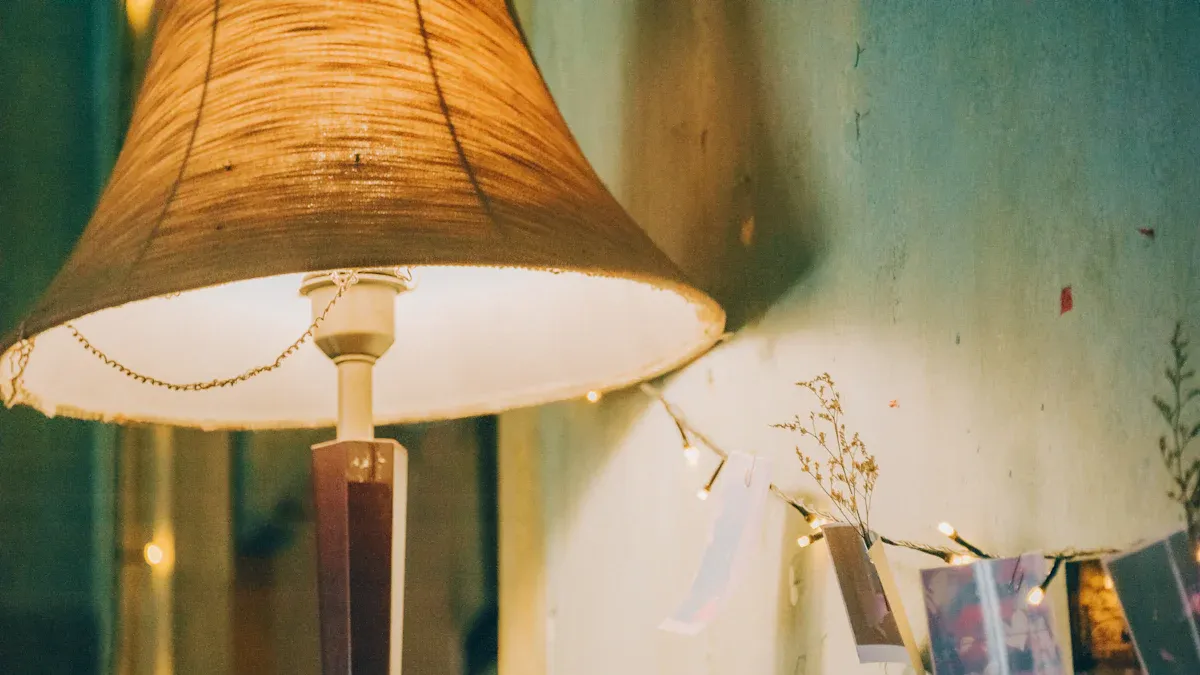
Table lamps do more than light up a room. When you use soothing, adjustable lighting, you can actually lift your mood and feel more at ease. Studies show that dynamic lighting—ranging from 260 to 550 lux and color temperatures around 2700K in the evening—can boost your sense of comfort and happiness. The emotional value provided by the table lamp is real: people report less stress and even less social isolation when they add cozy, warm light to their space. Why not try it and see how your nights change?
Warm, soft light from table lamps makes your home calm and cozy. This kind of light can help lower stress and make you feel happier. Adjustable table lamps let you change how bright or colorful the light is. You can pick the best light for relaxing, reading, or working. Put your table lamp close to where you relax, but not right at your eyes. This makes your room feel more peaceful and comfy. Using table lamps with warm bulbs at night helps your body get ready for sleep. It can help you fall asleep faster. If you use table lamps with other lights, your room looks deeper and warmer. This makes your space feel friendly and cheerful.

You might not realize it, but the light in your home can change how you feel. Scientists have found that different colors and brightness levels can shift your mood in big ways. For example:
Red light can make you feel calm or relaxed, but it can also cause irritation or nervousness.
Blue light often helps you feel more stable and less irritated.
Green and yellow lights can boost feelings of pleasure and reduce irritation.
One study even showed that when people sat in bright light, they felt warmer and their emotions became stronger. Dimmer light, on the other hand, made people feel more at ease and less intense. So, if you want to feel cozy and happy, you should try softer, warmer lighting in your space.
Tip: Warm light with a color temperature between 2000K and 3000K is best for creating a peaceful mood. It feels like the gentle glow of a sunset or candlelight.
You can use table lamps to help your body relax after a long day. Bright, cool lights can make you feel alert, but they might also keep your brain awake when you want to wind down. Warm, dim light tells your body it’s time to rest. This kind of lighting helps your brain make melatonin, the hormone that helps you sleep.
When you switch on a table lamp with a soft, warm bulb, you create a little oasis of calm. You might notice your stress melting away as the room fills with gentle light. Cozy lighting can help you let go of worries and enjoy a peaceful evening at home. Try it tonight—your mind and body will thank you.
When you turn on a table lamp with a warm glow, your room instantly feels more welcoming. The emotional value provided by the table lamp starts with this simple change. You might notice that you feel calmer and more at ease. Warm white light, especially in a white or neutral room, can make you feel cozy and safe. People often say that warm light helps them relax after a busy day.
Warm white light in a room makes you feel more calm and comfortable than cool white light.
Many people describe warm light as both calming and a little exciting, which helps lift your mood.
The emotional value provided by the table lamp grows when you use it to create a soft, gentle atmosphere.
If you feel anxious, you might find that warm lighting helps you settle down and feel less tense.
When you choose a table lamp with a warm bulb, you give yourself a little pocket of comfort. You can curl up with a book or just enjoy the peaceful feeling that fills the space.
The emotional value provided by the table lamp goes beyond just comfort. You can use adjustable, localized lighting to shape your mood and support your emotional balance. Table lamps let you control the brightness and direction of light. This means you can create a space that feels just right for you.
You might want a soft glow for winding down, or a brighter spot for reading or working on a hobby. The emotional value provided by the table lamp comes from this flexibility. You get to decide how your space feels, and that control can make you happier.
Table lamps help you focus light where you need it, so you can avoid harsh overhead lights.
You can use a dimmer or a lower-wattage bulb to keep the light gentle and soothing.
The emotional value provided by the table lamp increases when you use it to set the mood for different activities, like relaxing, chatting with friends, or enjoying a quiet evening.
Try moving your table lamp to different spots in your home. Notice how the light changes the way you feel in each space. You might be surprised at how much happier and calmer you feel with just a small change.
You can change the mood of a room just by moving your table lamp. Place your lamp where you spend the most time relaxing, like next to your favorite chair or on a bedside table. If you want to create a calm spot, try putting your lamp away from direct eye level. This helps soften the light and makes the space feel more peaceful. Studies show that the way you position your lamp, along with the color of your walls and decorations, can really affect how comfortable and happy you feel. When you match the lamp’s brightness and placement with your room’s colors, you create a space that feels just right for you.
Tip: Try different spots for your lamp. Notice how the light changes the mood in each area. You might find a new favorite place to unwind.
Layering light means using more than one type of light in a room. You can mix table lamps with ceiling lights and floor lamps to make your space feel cozy and interesting. Here’s how layering light helps:
You can adjust the light for different activities or moods.
Table lamps add depth and make a room feel more inviting.
Accent lighting, like table lamps, creates a warm, intimate atmosphere.
Dimmers and layered lights give you more control over how your room feels.
Placing lamps in key spots draws attention and helps you feel more comfortable.
Try using a table lamp with other lights to see how the room changes. You might notice you feel calmer and more at home.
Table lamps can help you wind down at night. Warm, soft light from a lamp supports your body’s natural sleep cycle. Unlike bright or blue lights, warm lamps do not stop your body from making melatonin, the hormone that helps you sleep. Many people find that using a table lamp in the evening helps them relax and fall asleep faster. Lamps with adjustable brightness let you set the perfect mood for reading, journaling, or just getting ready for bed.
Warm light (2700K to 3000K) helps your body get ready for sleep.
Dimmable lamps let you lower the light as bedtime gets closer.
Using a table lamp instead of overhead lights can make your evenings feel more peaceful.
Try making a habit of turning on your table lamp an hour before bed. You might notice you sleep better and feel more rested in the morning.

When you pick a table lamp, the bulb and its color temperature matter a lot. The right light can help you feel more alert, focused, or relaxed. Here’s what studies have found:
Lighting with higher color temperatures (around 6500 K) boosts your alertness and helps you focus better than lower color temperatures (3000-3500 K).
LED lamps and cool fluorescent lamps at 6500 K improve typing speed and accuracy.
Blue light-rich bulbs at higher color temperatures can make you feel more awake and help your memory.
Some people prefer 4000 K lighting for comfort, but higher color temperatures usually help with attention and mood.
LED lamps also help reduce mental fatigue and improve reaction times.
If you want to relax in the evening, choose a bulb with a warm color temperature (2000K-3000K). For studying or working, a cooler bulb (4000K-6500K) can help you stay sharp. You can even try bulbs that let you change the color temperature for different times of day.
Tip: Try using a warm bulb for your bedroom and a cooler one for your desk. Notice how your mood and focus change.
You get the most out of your table lamp when you can adjust it. Lamps with dimmers, color temperature controls, or smart features let you set the perfect mood for any activity. You might want bright, cool light for homework or crafts, then switch to a soft, warm glow for reading or relaxing. Adjustable lamps help you avoid eye strain and make your space feel just right.
Many people find that being able to change the light helps them feel happier and more comfortable. You can match the light to your needs, which supports your emotional wellbeing and helps you enjoy your space even more.
Table lamps do more than light up a room—they show off your style. The right lamp can make your room feel cozy, modern, or playful. Market research shows that more people want lamps that fit their personal taste and improve the mood of their home. Lamps are now the most popular decorative accessory because they are easy to change and can quickly update a room’s look.
You can find lamps in all shapes, colors, and materials. Some people like classic designs, while others want bold, trendy styles. Many shoppers look for lamps that use energy-saving LEDs or smart bulbs, which add both style and function. When you pick a lamp that matches your personality, you create a space that feels like home.
A table lamp is a small change that can make a big difference in how your room looks and feels. Try a new style and see how it lifts your mood!
You can make your home feel calm and happy with a table lamp. Research shows indoor lighting, like table lamps, helps people feel better. Here are some results:
|
Measure |
Result |
|---|---|
|
Pooled effect size |
0.53 |
|
Confidence interval |
0.35 to 0.72 |
|
Number of studies |
30 |
Try moving your lamp or using a new bulb. You could also start a new evening routine. The emotional value provided by the table lamp helps your space feel peaceful and joyful. Try it out and see if your mood gets better!
You can start with one or two table lamps. Place them where you relax most. If your room feels too dark, add another lamp. Try different spots until the space feels cozy and balanced.
Choose a warm white bulb between 2000K and 3000K. This color feels soft and gentle, like candlelight. It helps you relax and unwind after a busy day.
Yes! Using a table lamp with warm, dim light in the evening tells your body it’s time to rest. You may fall asleep faster and wake up feeling more refreshed.
Put your lamp near your favorite chair or bed.
Avoid placing it right at eye level.
Try different spots and see which one makes you feel happiest.